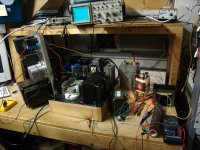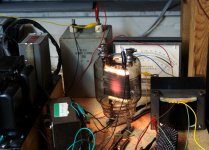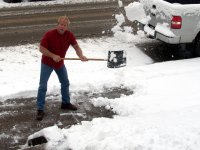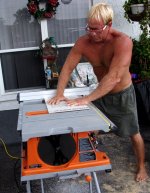Well you could say it's two phase from the 120V perspective, but it's still only single phase 240V across both "hots".
Over here it's 3xL+N to the house, we don't have one of those phases split any further. Three phase gear runs on 400V (interphase), most appliances use 230V (single phase).
`Got` that USA power system now.Basickly is the same system like here in Europa,only diference is that: the each 3 phase(3x400v)is divided in half with zero conductor placed in midle of each 3phase secondary distribution (step down)transformer.So from wall socket you can have various choice of voltage(120v for small load,240 for midle load.and 3x400v for BIG load.BTW TESLA 3 phase system was actualy small breadboard construnction intented for schoolklases purposes(to kids learn basic of POLYPHASE Electric System).Got the oportunity to see one of this original(beatyfooly handcrafted) small device in TESLA Museum -Belgrade.We steel use 3phase sistem-DId we are schoolklasses Kids?Best wishes DIY Friends.
The US is truely a strange place. Over here if you call for a certain supply, you get it. All our ovens are 3-phase wired. Most of the bigger E-Motors wouldn't run on single phase, even if you asked them nicely. How would I get my belt grinder to run without it?.. Aux phase is not really an option for supplying bigger tools.
It all comes down to economics. In most residential areas 3 phase distribution (the main HV feeds to the heighboorhood) runs down the main street central to the area. The "laterals" (the HV feed down each side street) have only one HV wire running down the poles between the houses. I am at the very end of the lateral. So even if they wanted to supply 3 phase power to my house, two new wires would need to be run a distance of about 3/4 of a mile. For at least 95% of all households, the existing single phase power is more than sufficient. So would FPL run a lot of extra wiring for a few users? Not here.
What is odd is that the shopping centers that border the neighboorhood all have 3 phase power in several voltage levels, but the houses that back up to the shopping centers can't get 3 phase. It is "policy".
Hey, my small house gets 36 KW of power, I have lived here for over 30 years, and even I haven't tripped the main breaker yet. I could get 12 KW into this room without too much work, but I could not get 6 KW of heat out of here (assuming some "device" with 50% efficiency). Right now I have the TV, the computer and the shop lights on, it has been raining all day and I have my air conditioner on. It is 80 degrees F in here. Turning on my usual complement of tube experimenting stuff (power supplies, scope, second computer, etc) requires a second AC unit. That's just life in the tropics.
What is odd is that the shopping centers that border the neighboorhood all have 3 phase power in several voltage levels, but the houses that back up to the shopping centers can't get 3 phase. It is "policy".
Hey, my small house gets 36 KW of power, I have lived here for over 30 years, and even I haven't tripped the main breaker yet. I could get 12 KW into this room without too much work, but I could not get 6 KW of heat out of here (assuming some "device" with 50% efficiency). Right now I have the TV, the computer and the shop lights on, it has been raining all day and I have my air conditioner on. It is 80 degrees F in here. Turning on my usual complement of tube experimenting stuff (power supplies, scope, second computer, etc) requires a second AC unit. That's just life in the tropics.
talking phase and loose here
"Three-wire, 120/240 volt single phase power used in the USA and Canada is sometimes incorrectly called "two-phase". The proper term is split phase or 3-wire single-phase."
Two phase is something entirely different, where the two phases are 90 degrees apart.
Two-phase electric power - Wikipedia, the free encyclopedia
In three phase the three phases are 120 degrees apart.
Polyphase transformers require a core per phase. A single phase transformer has one core, center tapped or not. A two phase transformer has two cores. A three phase transformer has three cores. I'm not sure where the point of diminishing returns is ... hmm, actually I am pretty sure the commercial optimum is somewhere between 3 phase and 4 phase, depending on the mix of distribution, voltage conversion, and rotating equipment in the plant.
The power transmitted is not a multiple of the number of phases, rather the square root of the number of phases, due to the phases being shifted in phase. Thus a three phase system transfers 1.732 times as much energy using 3 conductors as a single phase system using 2 conductors, service voltage and conductor size being equal. A four phase system transfers 2 times as much energy using four conductors, seemingly a wash but there are other savings in switchgear, conduits, etc. and especially rotating equipment.
But I would think a twelve phase system to be past the point of diminishing returns for widespread use. The power transfer goes up to 3.46x a single phase system using twelve conductors vs two. Not to mention those twelve core transformers, or is it six cores?
Well you could say it's two phase from the 120V perspective, but it's still only single phase 240V across both "hots".
"Three-wire, 120/240 volt single phase power used in the USA and Canada is sometimes incorrectly called "two-phase". The proper term is split phase or 3-wire single-phase."
Two phase is something entirely different, where the two phases are 90 degrees apart.
Two-phase electric power - Wikipedia, the free encyclopedia
In three phase the three phases are 120 degrees apart.
Polyphase transformers require a core per phase. A single phase transformer has one core, center tapped or not. A two phase transformer has two cores. A three phase transformer has three cores. I'm not sure where the point of diminishing returns is ... hmm, actually I am pretty sure the commercial optimum is somewhere between 3 phase and 4 phase, depending on the mix of distribution, voltage conversion, and rotating equipment in the plant.
The power transmitted is not a multiple of the number of phases, rather the square root of the number of phases, due to the phases being shifted in phase. Thus a three phase system transfers 1.732 times as much energy using 3 conductors as a single phase system using 2 conductors, service voltage and conductor size being equal. A four phase system transfers 2 times as much energy using four conductors, seemingly a wash but there are other savings in switchgear, conduits, etc. and especially rotating equipment.
But I would think a twelve phase system to be past the point of diminishing returns for widespread use. The power transfer goes up to 3.46x a single phase system using twelve conductors vs two. Not to mention those twelve core transformers, or is it six cores?
tubelab,
yeah, I get that, it boils down to infrastructure. But it's gotta suck thunder-and-lightning-big-time if you e.g. want to set up a nice little machine shop at home.
Florida seems to be warmer then I thought. Don't you have proper winters, when it makes perfect sense to use a nice tube radiator? ;-)
yeah, I get that, it boils down to infrastructure. But it's gotta suck thunder-and-lightning-big-time if you e.g. want to set up a nice little machine shop at home.
Florida seems to be warmer then I thought. Don't you have proper winters, when it makes perfect sense to use a nice tube radiator? ;-)
We are much like Europe here, if you want to pay to connect 3 phase then you can have it. Anywhere. Every street has 415V 3 phase cabling (supposed to be 400V now, but they cheat). Not all that many houses have it, 20A 240V (230V according to the newer spec, but not in reality) outlets are easy to arrange and 4.8KW is enough for most things at home. 10A outlets are standard.
Florida seems to be warmer then I thought. Don't you have proper winters, when it makes perfect sense to use a nice tube radiator?
In a typical year we might have 2 or 3 days where I need more than a T shirt to go outside. A "cold front" pushes through dropping the temps to near freezing at night a few times a year, but it is usually 60 F by day, and that only lasts 1 or 2 days.
This winter has been far from normal for most of the Northern Hemisphere. We have had a few week long periods of low temps including a week of freezing nights with 50 F days. To me it is a welcome change, but the tourists really don't like it. Thursday it was 85 F, Yesterday the front came through so it rained all day, this morning it was about 55 F outside but by this afternoon it will be 75 and near 80 tomorrow.
About 2 weeks ago I recall just how unstable our weather can be. Sherri and I went to Walmart. The dash thermometer in the car read 73 degrees as we went in to the store. The sun was shining. After about an hour inside we left. A strong cold blowing rain was in my face as I ran to the car and the dash thermometer read 52. A 21 degree drop in an hour.
Tubelab,
You might be able to get the heat from a monster amp out of the house using a heat pipe. Of course, it would mean that the amp enclosure would likely be about 10 to 20 degrees warmer than the space that sinks the heat (likely, the outside). If you want to get exotic, sink the heat to a ground loop. Ground temperature is around 72 degrees in Florida year around. All that would be required is a small water pump, a bunch of tubing, and an old (recycled) cooling coil from an air handler. Another option would be to sink the heat to a small cooling tower or even a swimming pool. Everybody in Florida has access to a swimming pool. If you don't have one, I bet the neighbor does; just don't let them see you drop the suction and return hoses into their pool. Just think, you get new amp and the wife gets a heated pool out of the deal, that's year round use of the pool. Of course, there would need to be some engineering involved, but I do this kind of stuff every day. I'd be glad to offer up some calculations on the cooling side of things.
Just think, you get new amp and the wife gets a heated pool out of the deal, that's year round use of the pool. Of course, there would need to be some engineering involved, but I do this kind of stuff every day. I'd be glad to offer up some calculations on the cooling side of things.
Regarding commercial properties getting3 phase, it all comes down to how much energy they will consume. Power companies are more than glad to provide high power to a user that will buy enough power to make it worth their while. Not likely from a residential user.
You might be able to get the heat from a monster amp out of the house using a heat pipe. Of course, it would mean that the amp enclosure would likely be about 10 to 20 degrees warmer than the space that sinks the heat (likely, the outside). If you want to get exotic, sink the heat to a ground loop. Ground temperature is around 72 degrees in Florida year around. All that would be required is a small water pump, a bunch of tubing, and an old (recycled) cooling coil from an air handler. Another option would be to sink the heat to a small cooling tower or even a swimming pool. Everybody in Florida has access to a swimming pool. If you don't have one, I bet the neighbor does; just don't let them see you drop the suction and return hoses into their pool.
Regarding commercial properties getting3 phase, it all comes down to how much energy they will consume. Power companies are more than glad to provide high power to a user that will buy enough power to make it worth their while. Not likely from a residential user.
Florida seems to be warmer then I thought. Don't you have proper winters,
No winter, February at the beach.
Anyway it's not that hot, it's the humidity that kills me. The sticky air, you can't go for a walk... I always need a shower.
I'm talking about Miami, south Florida.
I'm talking about Miami, south Florida.
I grew up in Miami and we did not have AC until I was in high school. I now live in a suburb of Fort Lauderdale about 20 miles north of Miami.
Anyway it's not that hot, it's the humidity that kills me. The sticky air, you can't go for a walk... I always need a shower.
Maybe I'm just getting old but the heat and humidity bother me a lot more now than it did 10 years ago, and I can't even figure how I grew up without AC.
Another option would be to sink the heat to a small cooling tower or even a swimming pool. Everybody in Florida has access to a swimming pool......Just think, you get new amp and the wife gets a heated pool out of the deal, that's year round use of the pool.
Of course I have a swimming pool, and for me it IS a year round pool. I go swimming almost every day regardless of the water temp. I have been in the pool twice today. Sherri however is always complaining that the water is too cold.
The pool = heat sink is a good idea that I haven't thought of, and it may not be all that difficult since the pool pump is not far from this room and I already have a hole in the wall for all of my ham radio cables. I'll have to think about this one some more. I doubt that the duty cycle of such an amp would raise the water temp significantly though. It is about 40,000 liters!
Now that brings up more questions. Would that new killowatt amp be RF or audio, and tube or SS? Let see, maybe I could build something that covers 20 Hz to 20 KHz AND 1.8 to 30 MHz. Now how would I liquid cool a pair of 833A's?....Or maybe a quad of 813's......or maybe a whole box full of sweep tubes....or.....hell mosfets would be easier.....no, wrong forum.....brain overheating, time to jump in the pool!
I can't even figure how I grew up without AC
Neither can I.
Anyway a 200W tube amp? You haven't changed that much.
I've been in Fort Lauderdale, nice place to live.
The pool = heat sink is a good idea that I haven't thought of, and it may not be all that difficult since the pool pump is not far from this room and I already have a hole in the wall for all of my ham radio cables. I'll have to think about this one some more. I doubt that the duty cycle of such an amp would raise the water temp significantly though. It is about 40,000 liters!
We tried using a pool as a heat sink for a household AC unit to increase efficiency. A long coil of copper tubing inside a large PVC pipe at the filter inlet. It worked, but wasn't a dramatic improvement. It was an ideal setup with the compressor only 10 or 20 feet from the pool itself.
I can't function in high humidity. We do get that kind of weather here, often in late June through July. It can be pretty sweltering and really sux with those persnickety Chrysler AC compressors. Last summer was mild..only one week or so in the mid-high 90s.
Last edited:
Hello tubelab, you could really go nuts and use one of the transmitting tubes that were made to be liquid cooled. Of course the one I remember seeing a pic of was around 5 feet tall. Don't remember the number. Below is a link I found when did a google search for 'liquid cooled vacuum tubes'
Vacuum Tube Liquid Cooling
Peace,
Dave
Vacuum Tube Liquid Cooling
Peace,
Dave
Hello tubelab, you could really go nuts and use one of the transmitting tubes that were made to be liquid cooled.
The EME (moonbounce) guys are using 2C39's with the radiating fins removed and the tube itself screwed into the heat exchanger. I have a good collection of these tubes, but their suitability for audio is unknown.
My experiments with the 833A in SE mode told me that finding an OPT for a mega-powered SE amp is unlikely. It also taught me about the heat buildup issue. So whatever I build will be P-P which means 4 tubes. With my current schedule and the backlog of unfinished projects, nothing is going to happen any time soon, but dreaming up new ideas doesn't cost anything......yet!
For those who are not familiar with those experiments, I'll enclose a couple of pictures. The first shows how I wired an 833A into my existing 845SE amp. The second is a close up of the 833A in action.
The 845SE amp was built on two chassis. The chassis in the back center of the picture is the power supply. It provided filament, driver power, and 1050 volts at 200 mA. That power supply proved inadequate to crank a single 833A into the red zone, so the chassis on the left was liberated from a surplus Motorola ambulance transmitter. It provides 1500 volts at 1/2 an amp. The power transformer weighs 75 pounds. I have 3 of these power supplies! The chassis in the front center is my 845SE amp. It was not modified, but I needed to run an external bias supply to feed the PowerDrive circuit some positive grid voltage. On the right is the 833A tube. Note the unorthodox connections made with vice grips and hose clamps. Like they say on Mythbusters, DONT TRY THIS AT HOME. During testing there was a 1/4 inch Lexan shield between me and the bench. It was removed for some photos. Of course a fire extinguisher was nearby!
The whole story is here:
The 833A SE Amp Prototype
Attachments
what rotten luck do I owe the pleasure of living in a country that has had three straight months of snowing and freezing till two days ago
Most of the US has been blasted by record snowfall this year too. The weather in south Florida is nice this time of year. It sucks pretty bad during the summer though, so you trade the cold and the snow for heat, rain and bugs, it just comes at a different time of year. I can work outside on projects from November through March, on about 50 to 75% of the days. Despite what the tourist brochures may say it rains in the winter. Yesterday we got almost 2 inches of rain with 40 MPH winds. Today it was windy, but very nice, tomorrow should be good too, then rain again on Monday or Tuesday. From May through September the humidity varies from 80% to 100% (raining), the temp varies from 85 to 100 degrees F. Gnats and mosquitos attack without mercy. Working outside on wood, cars, or anything that should be dry is impossible because I will be dripping sweat within 5 minutes.
Enclosed are two pictures, both taken in December, one in my front yard, one in my mother-in-laws front yard. Can you guess which is which?
Attachments
- Status
- This old topic is closed. If you want to reopen this topic, contact a moderator using the "Report Post" button.
- Home
- Amplifiers
- Tubes / Valves
- Monstrous 1kW amp!



